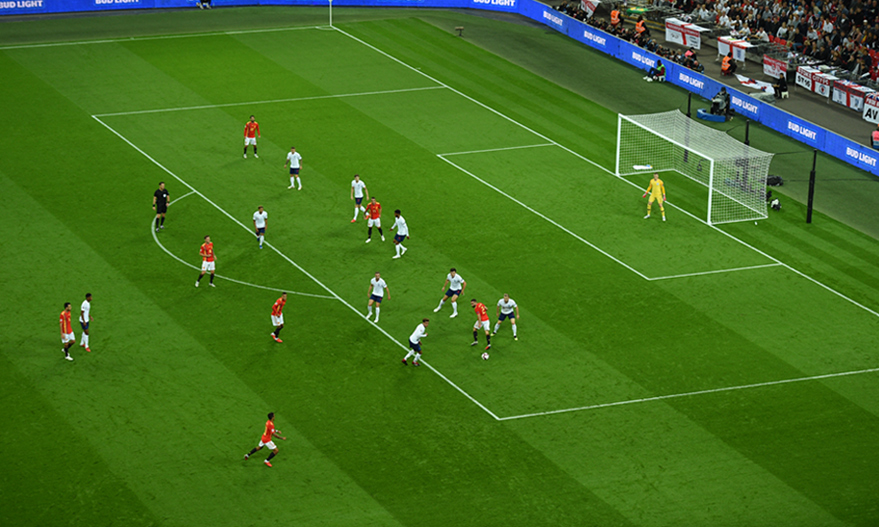Table of Contents
In the landscape of modern football tactics, defensive organization is as critical as attacking fluidity. Among the most prominent and systematically employed defensive frameworks is the low block—a compact, resilient approach that has shaped how teams contain opposition dominance. This article presents a tactical deep dive into what is low block in football, examining its definition, structural components, implementation, and tactical significance within elite-level football.
Defining the Low Block: What is Low Block in Football?
In football terminology, a low block is a structured defensive approach where a team positions the majority of its players deep within its own half, typically just outside or inside the defensive third. This strategy is designed to limit space between lines, restrict passing lanes, and deny the opposition opportunities to penetrate the defensive shape.
Unlike mid or high pressing systems, the low block forgoes territorial control in favor of positional discipline, spatial compactness, and zonal coverage. The defensive line operates in close proximity to the goalkeeper, supported by a densely packed midfield that collectively aims to congest central areas and force wide, less dangerous play.
Tactical Origins and Historical Development
The conceptual roots of the low block can be traced to classical Italian Catenaccio systems and defensive setups of Eastern European teams in the late 20th century. However, its refinement and mainstream adoption in modern football owe much to tacticians such as José Mourinho and Diego Simeone.
Mourinho’s tenure at Inter Milan during the 2009–10 season remains a textbook example, particularly in their UEFA Champions League semi-final against Barcelona, where defensive compactness was coupled with explosive counterattacking transitions. Similarly, Atlético Madrid under Simeone have consistently deployed a 4-4-2 low block with remarkable discipline, frustrating some of Europe’s most creative attacking units.
Structural Characteristics of a Low Block System
A well-executed low block system is defined by its deep line of engagement, high vertical and horizontal compactness, and zonal marking principles. Defenders maintain tight spacing to reduce channels between the lines, while midfielders drop deep to protect the defensive third. Central access is deliberately restricted, forcing opposition play into wide areas with reduced threat.
Selective pressing occurs based on specific triggers, such as an opponent receiving with their back to goal or a poor first touch. The objective is to maintain structure while applying pressure only when it can lead to ball recovery without compromising shape.
This level of cohesion demands constant communication, spatial awareness, and tactical discipline from every player on the pitch.
Advantages and Drawbacks of the Low Block
The low block provides a robust defensive foundation, allowing teams to neutralize technically superior opponents through positional excellence. By defending deep and in numbers, the system minimizes gaps and limits high-quality goal-scoring opportunities. It also conserves player energy and creates space in transition, enabling rapid counterattacks.
However, this strategy is not without its limitations. Surrendering territory invites prolonged pressure, which can lead to fatigue and defensive errors. Teams may struggle to build meaningful possession from deep areas and are often reliant on individual brilliance during transitions or set-piece situations. Additionally, opponents with strong long-range shooters or intricate short-passing play can find ways to break down a passive block.
Implementing the Low Block: Coaching Considerations
Effective implementation of the low block requires deliberate tactical training. Coaches often prefer formations such as the 4-4-1-1 or 5-4-1 to optimize both width and central compactness. Each player must understand their spatial responsibilities and movement patterns, ensuring seamless lateral shifts and vertical compression as the ball moves.
Drills focus on maintaining shape under pressure, reacting to positional triggers, and executing transitions swiftly. Midfielders are often tasked with dual responsibilities—screening passes into the final third while initiating breaks upon possession recovery. The success of the low block depends as much on discipline and coordination as it does on physical and technical attributes.
Notable Case Studies from Professional Football
Several top-tier clubs have demonstrated the effectiveness of a disciplined low block. Diego Simeone’s Atlético Madrid stands as the modern benchmark, with their compact 4-4-2 structure consistently stifling elite attacks across Europe. The team’s defensive records and tournament performances highlight the power of collective organization.
José Mourinho’s Inter Milan, particularly during the 2009–10 Champions League campaign, provided a masterclass in reactive defending. Against possession-heavy Barcelona, Inter’s low block absorbed sustained pressure while striking decisively on the counter.
Leicester City’s 2015–16 Premier League title run under Claudio Ranieri also exemplified the low block in action. With disciplined lines and rapid transitions, Leicester controlled matches without dominating possession, relying on compact defending and the pace of Jamie Vardy to punish overcommitted opponents.
Countermeasures and Tactical Responses
Breaking down a low block requires patience, creativity, and technical precision. Progressive teams often utilize width to stretch the defensive shape, deploy overlapping full-backs to deliver dangerous crosses, and execute quick combinations in tight spaces to disrupt compact structures.
Effective ball circulation, attacking rotations, and long-range shots further increase the probability of success against a disciplined block. Coaches may also instruct their midfielders to make late runs into the box or deploy false nines to draw defenders out of position and create gaps.
Despite its strengths, the low block can be exposed by teams with high tactical intelligence and positional fluidity capable of unlocking compact defenses.
Conclusion
Understanding what is low block in football offers vital insight into one of the most effective defensive mechanisms in the modern game. Built on structure, sacrifice, and collective discipline, the low block exemplifies how strategic depth can neutralize technical superiority.
Far from being a defensive retreat, the low block is a calculated response to modern attacking systems. When deployed with precision, it transforms the defensive third into an impenetrable zone and provides a platform for structured, often devastating counterattacks. In a game increasingly defined by possession and pressing, the low block remains a tactical equalizer—subtle, strategic, and undeniably effective.








